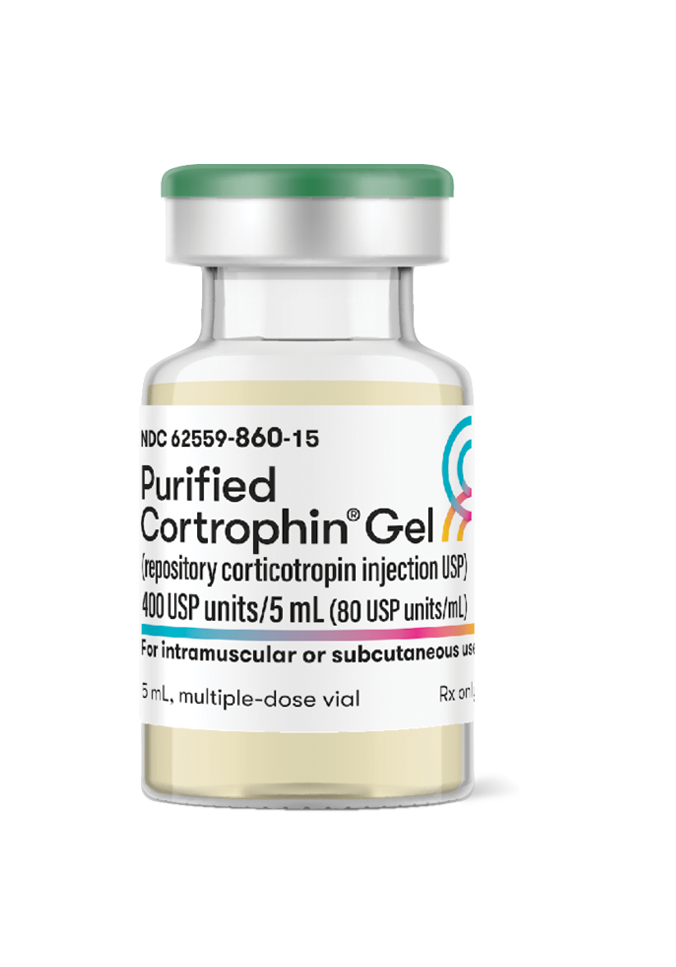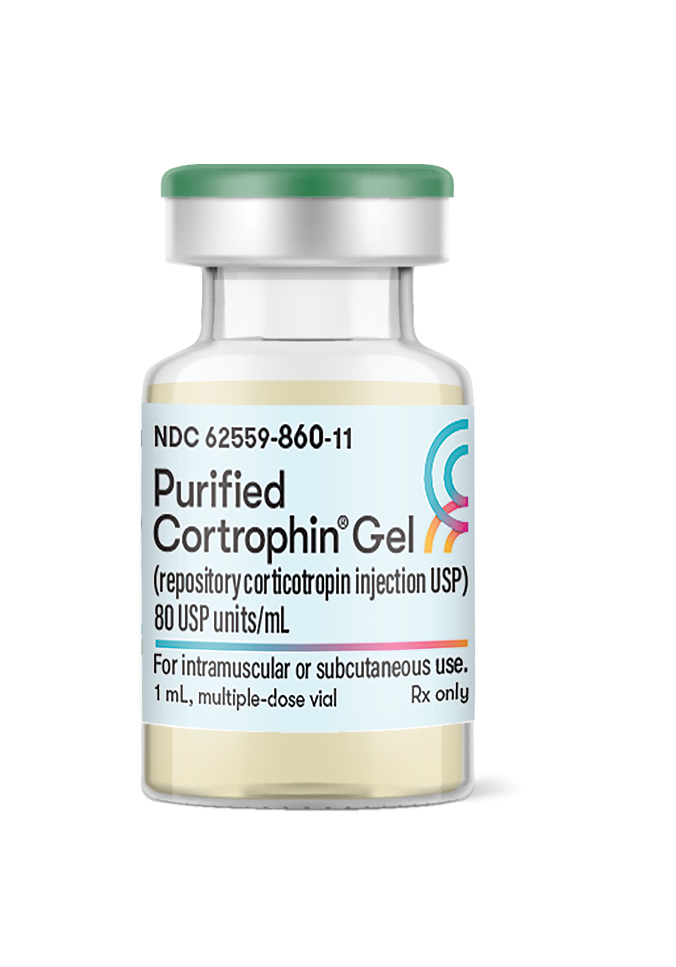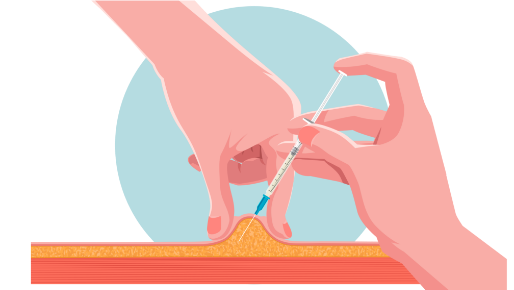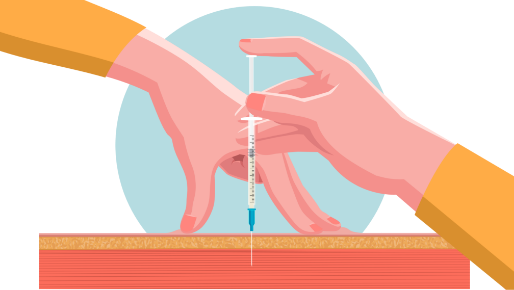Introducing Cortrophin Gel
If you have been prescribed Cortrophin Gel, you can use this video for step-by-step instructions on how to administer treatment.
Be sure to carefully read the Instructions for Use before using Cortrophin Gel. It contains additional information and safety precautions for administration.
It’s important that you receive training on how to administer Cortrophin Gel prior to injecting yourself or someone else.
Your healthcare provider should show you how to prepare and inject Cortrophin Gel the right way, including where and how to inject, how much to give, and how often to give it.
Do not inject yourself until you have been shown the right way to give your injections by your healthcare provider.
If you’d like additional support, the Cortrophin In Your Corner program* can help. The program offers in-person injection training provided by a licensed nurse at no cost to you.
If you have already been trained or have experience with self-injection, a virtual injection review session may better fit your needs.
If you have not received your injection training before starting treatment, you can call 1-800-805-5258 for assistance.
*Not all patients will be eligible for all services offered by Cortrophin In Your Corner.
If you have any questions about using Cortrophin Gel, please call your healthcare provider.
Collecting your supplies
Before starting, collect all the supplies you will need to use for preparing and injecting Cortrophin Gel. You will need the following:
- A vial of Cortrophin Gel
- A syringe
- A needle for withdrawal (20 gauge or as prescribed by your doctor)
- A needle for injection (23 gauge or as prescribed by your doctor)
- 2 alcohol pads
- Cotton balls or a gauze pad
- A bandage, if needed, and an appropriate container for throwing away used needles
Preparing to inject
Before preparing to inject, be sure to check the expiration date on your Cortrophin Gel vial. Do not use if the expiration date on your Cortrophin Gel vial has passed.
Throw away (discard) any 1-mL vials 6 months after first use or by the expiration date printed on the label, whichever occurs first.
Throw away (discard) any 5-mL vials 28 days after first use or by the expiration date printed on the label, whichever occurs first.
Write the revised discard by date in the space provided on the carton labeling.
Always keep Purified Cortrophin Gel and all medicines out of the reach of children.
When you are ready to inject, wash your hands well and dry them with a clean towel.
Remember, the medicine in the vial will need to be warmed after you remove it from the refrigerator prior to injecting. This can be done by rolling the vial between your hands for a few minutes.
You will know it is ready when the medicine is a liquid gel and not a solid gel.
Do not microwave or heat the vial on the stove to warm.
Once the vial is ready, remove the plastic cap from the top of the vial and throw it away.
Do not put the plastic cap back on the vial when you are done injecting.
Next, wipe the rubber stopper on the top of the vial with a new sterile alcohol pad. Allow the alcohol to air dry. Do not wipe it off.
Attach a new sterile 20-gauge needle (or needle size as prescribed by your doctor for withdrawal) to the syringe, remove the needle cap, make sure the plunger is pushed all the way down to confirm no air is in the syringe, and insert the needle through the rubber stopper.
Pick up the vial and turn it upside down. With the needle in the medicine, pull back the plunger to draw up the amount of Cortrophin Gel your healthcare provider has told you to use.
If there are any air bubbles in the syringe, tap the side of the syringe to help them rise toward the needle end.
Then, slowly press the plunger until all bubbles are removed from the syringe.
Be sure to check that you still have the right amount of medicine in the syringe for injection before removing the needle from the vial.
Once confirmed, you can return the vial to the refrigerator.
Making sure no medicine is in the needle, replace the 20-gauge needle (or the one prescribed for withdrawal) with the 23-gauge needle (or the one prescribed for injection).
Do not use the 20-gauge needle for injecting.
You are now ready to inject.
Injecting under the skin
Before you administer treatment to yourself or someone else, it’s important you review the appropriate areas for an under-the-skin, or subcutaneous, injection.
This section includes guidance for injecting into the upper thigh, abdomen, and side or back of the upper arm.
Ask your healthcare provider which injection areas are best for you. Give the injection the way your healthcare provider has instructed you.
You may inject into the same area multiple times a week, but make sure you rotate the injection sites in that area each time according to your healthcare provider’s instructions, keeping at least 1 inch between sites.
Once you’ve decided on the location, the first step is to prepare the skin where you are going to give the injection by wiping it with a new sterile alcohol pad. Allow it to air dry.
Next, prime the needle for injecting by slowly pushing the plunger until a small droplet of medicine forms at the tip of the 23-gauge needle (or needle size prescribed for injection).
Pinch the skin around the injection site.
Do not touch the site where you plan to inject Cortrophin Gel.
Insert the needle at a 45-degree angle through the skin using a quick motion.
Stop pinching the skin and, holding the needle steady, push down on the plunger until all the medicine is emptied from the syringe.
Pull the needle out. There may be a little bleeding at the injection site. You can press a cotton ball or gauze pad over the injection site (do not rub). If needed, you may cover the injection site with a bandage.
Injecting into the muscle
Before you administer treatment to yourself or someone else, it’s important you review the appropriate areas for an into-the-muscle, or intramuscular, injection.
This section includes guidance for injecting into the upper-outer thigh muscle and the upper arm muscle.
Ask your healthcare provider which injection areas are best for you. Give the injection the way your healthcare provider has instructed you.
You may inject into the same area multiple times a week, but make sure you rotate the injection sites in that area each time according to your healthcare provider’s instructions, keeping at least 1 inch between sites.
Once you’ve decided on the location, the first step is to prepare the skin where you are going to give the injection by wiping it with an alcohol pad. Allow it to air dry.
Next, prime the needle for injecting by slowly pushing the plunger until a small droplet of medicine forms at the tip of the 23-gauge needle (or needle size prescribed for injection).
Stretch and hold the skin around the injection site.
Insert the needle at a 90-degree angle through the skin using a quick motion.
Stop stretching the skin and, holding the needle steady, push down on the plunger until all the medicine is emptied from the syringe.
Pull the needle out. There may be a little bleeding at the injection site. You can press a cotton ball or gauze pad over the injection site (do not rub). If needed, you may cover the injection site with a bandage.
Disposing of used supplies
After completing your treatment, put any used needles and syringes in a sharps container right away.
Do not throw away (dispose of) your used needles and syringes in your household trash.
If you do not have a sharps container, you may use a household container that:
- Is made of a heavy-duty plastic,
- Can be closed with a tight-fitting lid,
- Is puncture- and leak-resistant,
- and is properly labeled to warn of hazardous waste inside.
When your container is full, it is important to follow state and local laws regarding the proper disposal of it.
Your doctor, nurse, or pharmacist can provide you with instructions or you can visit the FDA's website.
Use & Important Safety Information
What is Purified Cortrophin Gel?
Purified Cortrophin Gel is a prescription medicine that is injected under the skin or into the muscle. It has a number of uses, including one for acute attacks or flares of multiple sclerosis, or another for symptomatic sarcoidosis. Talk to your doctor about other uses for Cortrophin Gel.
Important Safety Information
DO NOT use Cortrophin Gel if you have any of the following conditions:
- A skin condition called scleroderma
- Bone density loss or osteoporosis
- Fungal infections
- Ocular herpes simplex (an eye infection)
- A recent surgery
- Stomach ulcers or a history of stomach ulcers
- Heart failure
- High blood pressure
- Allergies to pig-derived proteins
- Adrenal glands that do not make enough of the hormone cortisol (primary adrenocortical insufficiency) or
- An adrenal cortex that makes too much of the hormones cortisol and aldosterone (adrenocortical hyperfunction)
Tell your doctor if you:
- Have or have had any other health problems
- Are taking any prescription or over-the-counter medicines, including aspirin, vitamins, and herbal or dietary supplements
- Have any allergies
- Are about to receive any vaccine
- Are pregnant or plan to become pregnant. Cortrophin Gel may harm your unborn baby.
- Are breastfeeding or plan to breastfeed. It is not known if Cortrophin Gel passes into your breast milk and if it can harm your baby.
What important information do I need to know about Cortrophin Gel?
Be sure to take Cortrophin Gel exactly as your doctor has directed. Always inject Cortrophin Gel under the skin or into the muscle. Do not inject Cortrophin Gel directly into the vein.
- You may be more likely to get infections. Contact your doctor at the first sign of an infection or fever.
- Your body may not produce enough natural cortisol after you stop taking Cortrophin Gel long term. This is called adrenal insufficiency. Your doctor may try to reduce your dosage gradually or prescribe a steroid medicine to protect you until the adrenal gland recovers.
- You might develop high blood pressure, retain too much salt and water, or have low blood potassium levels. As a result of this, your doctor may recommend some changes to your diet, such as eating less salt or taking certain supplements.
- Corticotropin therapy may hide symptoms of other diseases. This can make it more difficult for your doctor to make a diagnosis if something else is going on.
- Taking Cortrophin Gel can make you feel irritable or depressed. You may also have mood swings or trouble sleeping.
- You might develop certain eye conditions, such as cataracts, glaucoma, or optic nerve damage.
- You may develop allergies to Cortrophin Gel. Signs of an allergic reaction include dizziness, nausea and vomiting, shock, and skin reactions.
- The effects of Cortrophin Gel may be intensified if you have an underactive thyroid or cirrhosis of the liver.
Side effects of Cortrophin Gel include fluid or salt retention; weight gain; muscle weakness; osteoporosis, stomach ulcers with possible bleeding; injection site reactions; impaired wound healing; high blood pressure; convulsions; headache; development of Cushingoid state (a hormonal condition often characterized by facial puffiness and weight gain); and suppression of growth in children.
These are not all of the possible side effects of Cortrophin Gel. Call your doctor or pharmacist for medical advice about side effects. You may report side effects to ANI Pharmaceuticals, Inc. at 1-800-308-6755 or FDA at 1-800-FDA-1088 or www.fda.gov/medwatch.
What is Purified Cortrophin Gel?
Purified Cortrophin Gel is a prescription medicine that is injected under the skin or into the muscle. It is used for:
- Short-term add-on therapy to help manage acute episodes or flares in rheumatoid arthritis, including juvenile rheumatoid arthritis; psoriatic arthritis; ankylosing spondylitis; and acute gouty arthritis.
- Treatment for flares or as maintenance therapy in select cases of systemic lupus erythematosus and systemic dermatomyositis (polymyositis).
- Treatment for severe skin reactions (Stevens-Johnson syndrome) and severe psoriasis.
- Treatment for atopic dermatitis (eczema) and serum sickness.
- Treatment for severe acute and chronic allergic and inflammatory conditions affecting different parts of the eye. This can include the front part of the eye such as the cornea and iris, or the back part of the eye such as the optic nerve and retina.
- Treatment for people with symptoms of sarcoidosis.
- Reduction of protein in the urine of people with nephrotic syndrome of the idiopathic type (unknown origin) without uremia (accumulation of urea in the blood due to malfunctioning kidneys) or due to lupus.
- Acute attacks or flares of multiple sclerosis.
Please see full Prescribing Information.
Please see full Prescribing Information at Cortrophin.com.







